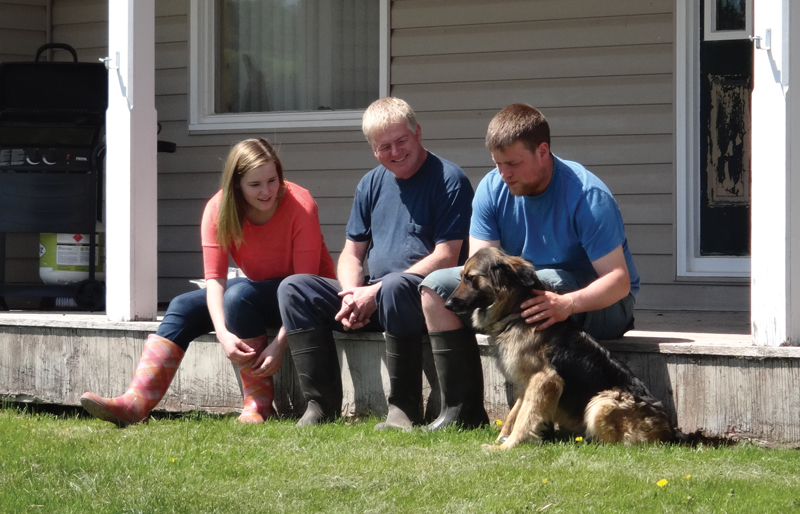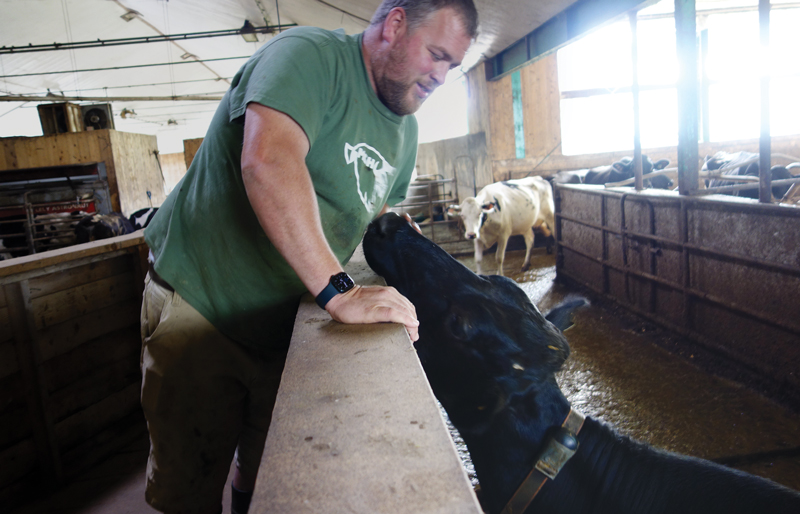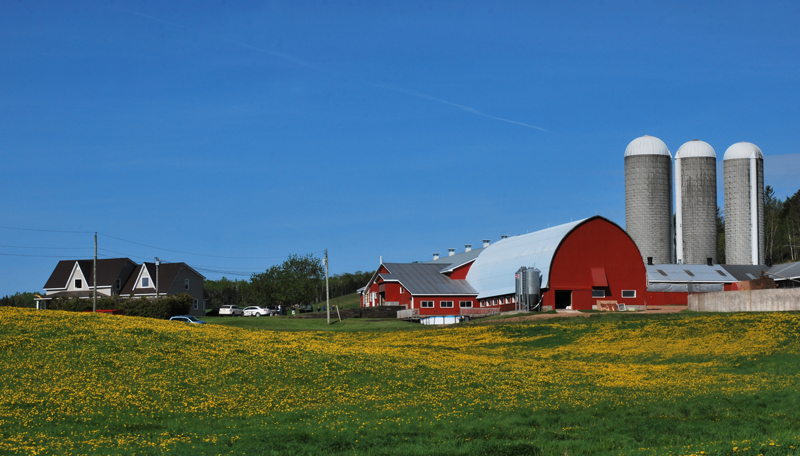Account Login
Don't have an account? Create One

“I call this ‘a cow-sized Fitbit’ because it knows how much they walk and it knows what their projected milk [production] of the day is,” explains Rothiemay Farms’ Jesse Mitham.
He’s holding a canvas belt, with a weight at one end and a transponder on the other, which his dairy cows wear like a necklace as they mill about the alleys of the 130-head farm just outside of Norton, New Brunswick.
Mitham, along with his father Bruce and mother Sarah, runs the family dairy and egg farm with the help of four other siblings who all grew up in the agriculture industry of southern New Brunswick.
Automation wasn’t as accessible back when Bruce and Sarah started the farm in 1981. Then, the constant labour of tending to the milking, feeding and cleaning schedules kept them close to home. Now, in 2023, automated technologies have not only liberated the Mitham’s strict morning and evening milking schedules, but have given the cows more autonomy too.
“I’ve got some cows in this herd getting milked 60 litres and they’ll get milked five to six times per day. And I have some cows in this herd only getting milked 10 litres… They only get milked once a day,” Jesse explained.
The transponder around each cow’s neck sends a signal to the Mitham’s robotic milking machine, to open the door to the stall and get the milking process underway. Inside the stall, the machine thoroughly cleans the udders with a combination of water and brushes, then attaches the milking apparatus and extracts the milk, all within a few minutes’ time. Cows get a little “candy” as Mitham calls it, silage or other goodies to munch on while the process is underway. Then they exit out the other side of the stall, making room for the next one in line.
“I used to have a cow that actually went to the robot 200 times to try to get milked,” Jesse said with a laugh.
The information in the transponder lets the machine know if that cow is ready to be milked. If it’s not, the cow enters the stall but no feed comes down and the exit door opens, sending it back out again so the line-up of other cows can keep moving.

“It just kept doing circles. But the robot’s just like—no, you can’t get milked,” Jesse recalls.
Since installing the robotic milking machines and other automations like alley scrapers (which remove manure) during a barn overhaul in 2016, the Mithams have seen a significant increase in production.
“When we first started milking [with the robot] we had a 1,500-gallon tank. I think it was three weeks later we had overfilled the 1,500-gallon tank and had to put a new one in,” Jesse said.
They now have a tank that holds approximately 2,500 gallons, the biggest sized tank they could fit in that part of the barn. They estimate they’ve seen an increase in production of at least one and a quarter gallons per cow “if not more” since adding these automations.
New Brunswick’s agriculture minister, Margaret Johnson, said 90 per cent of the 166 dairy farms in the province have adopted some form of automation, and the investment shows in the province’s dairy output. “New Brunswick is second only to Alberta in production per cow, and that’s the highest ranking we’ve ever had,” she said.
In 2021 the 16,599 dairy cows in New Brunswick produced 159.1 million litres of milk (42,029,773 gallons). In 2022, the dairy product manufacturing industry contributed $101.6 million to provincial GDP with dairy receipts totaling $142.6 million, accounting for 37 per cent of New Brunswick’s livestock receipts and 12 per cent of total farm cash receipts.
“It’s going to grow as we see the efficiencies on the farm,” Johnson said of automation. “Farmers recognize, regardless of the scale of their operation, how beneficial it can be.”
Lactanet is a national organization that provides herd management advice to dairy farmers across the country. In an email exchange with Atlantic Business, Lactanet’s regional manager for the Atlantic provinces, Jeff Gunn, said automation makes an impact on dairy farming in three significant ways.
“Number one is addressing the labour challenges for producers. In some areas of Atlantic Canada, it is difficult for dairy farmers to find people who want to work. This results in the owner and their family being tied to the farm 24-7. Automation helps to strike that work-life balance.”

“Number two … is the generation of more data. Data allows the dairy farmer and their team to benchmark their operation, identify bottlenecks, set goals, and set an action plan in motion, resulting in improved herd health and performance and ultimately, profitability.”
The third benefit is the efficient use of resources offered by automation, saving money and reducing a farm’s carbon footprint, Gunn said.
“When we researched robots, one of the farmers said ‘don’t expect to have all this free time’,” explains Rothiemay Farms’ Jesse Mitham about their decision to introduce automation. “I’m in the barn just as much, if not more, than I was before.”
Having the robot take over the early morning and late-night milking has reduced the farm’s need for labour, and made it easier to keep employees by providing work at more regular hours. “I was having a hard time getting employees here. Getting called at four o’clock in the morning that they’re not coming,” Jesse said.
In its 2019 report Farmer 4.0, RBC identified “the skills and labour crisis in agriculture, with a projected domestic shortage of 123,000 workers within a decade” as one of the biggest challenges facing Canadian farmers. It noted that automation and technology could help reduce that reliance on skilled labour.
Projecting that one quarter of Canada’s farmers will be 65 or older by 2025, the report noted that use of technology like robotic milking machines is increasing among younger farmers, with over 80 per cent of farmers under the age of 40 using automation and smart machines in their operations.

“Data allows the dairy farmer and their team to benchmark their operation, identify bottlenecks, set goals, and set an action plan in motion, resulting in improved herd health and performance and ultimately, profitability.”
—Jeff Gunn, Regional manager, Lactanet
Dubbing it the “fourth revolution in agricultural technology”, the report said farmers will need to “focus on strategy and systems, leaving past tasks to a new generation of smart machines.” In doing so, Canada “could gain $11 billion in annual GDP by 2030 by closing the agriculture labour gap and accelerating investment in technology.”
Bethany Deshpande, CEO of Maritime agri-tech company SomaDetect, and board member of the Canadian Agri-food Automation and Intelligence Network, said innovations like robotic milking systems help make life better for cows too. “They’re voluntary milking systems,” she explains. “Cows can get milked three or four times per day, whenever they want to, and that results in a healthier udder.”
She would know.
Her company, SomaDetect, based in Halifax and Fredericton, provides technology that detects the amount of soma cells—a marker of mastitis infection—in milk to alert farmers to changes in quality and quantity of production.
She said innovations like robotic milkers are fairly common in Europe, with up to 40 per cent of farms there using the machines as compared to a quarter of Atlantic Canadian dairy farms, but “they’re gaining traction quickly.”
“It’s something that’s growing at such a massive rate not only on dairy farms, but on crop farms, in almost every area of food and agriculture,” she said. “There’s so much pressure on these industries to be as efficient as possible. To reduce greenhouse gas emissions…. I think that producers are absolutely taking notice [of new technologies].”
“I think [farms] will have sensors everywhere,” she said of the coming decades of farming. “We already have weather and environmental sensors on farms, but I think we will have more sensors coming to market, monitoring every different aspect.”

She said farms will become more reliant on data science and will have experts at the ready “really churning through this data, and software that allows them to understand what levers they need to be pulling to maximize production.”
For some farmers, that future is now. “Our robot has an online somatic cell counter,” said dairy farmer Gilbert Matheson of Grant’s Breeder Farm outside of Saint John, of his automatic milking device. “Every cow, every day, we know exactly what that milk quality is. If there’s a cow that has some issues, number one, you can detect it pretty quick by looking at our reports.”
“Number two, we make sure it doesn’t go into the milking system.” He said the machine can detect and divert that milk away from the main milk tanks. “There’s automatic permissions you can set up there so you can say anything over a certain point, that gets diverted. Anything under goes into the tank.”
He said not all milking robots have the ability to detect the somatic cell counts, but it’s a technology he’s come to rely on. “To me, if you want to have better data, it’s necessary. If you can’t measure something, you can’t manage it.”
Then there are the other automations that make the cows lives better, like the automatic cow brush with the spinning soft bristles that groom the cow’s coat and keep them clean. “If they’re comfortable, if they’re happy, when they’re clean, they’ll perform just a little bit better,” Matheson said.
Back at Rothiemay Farms, Bruce Mitham agrees. “Cows like consistency,” he said. “When they eat more, they can produce more.”
The Mithams are also introducing automation into their feeding system. “We feed the big square bales with a skid steer [a little tractor] and corn silage is drizzled over it. That’s something that we’re automating now,” Bruce said, pointing to a long conveyer belt-like system on the ceiling directly over the central feeding stalls.

It’s something that’s growing at such a massive rate not only on dairy farms, but on crop farms, in almost every area of food and agriculture. There’s so much pressure on these industries to be as efficient as possible.”
—Bethany Deshpande, CEO, SomaDetect
“It’s going to run 10 times a day. Every two and a half hours the cows will get a little bit [of silage]. We’ll drizzle it over, just a little bit.”
It’s a job that’s currently being done by hand, with switches and meters run manually. The new system will be able to run 24 hours a day, much like the robotic milker, always providing that little nudge of available nutrition.
That said, you can still find some manual labour from the old days in bits and pieces of the farm.
“This is the only part we have to scrape by hand,” said Bruce, indicating the walkways connecting the outer alleys of stalls to the central alleys where hay and corn silage are dispensed.
Each of the four long alleyways that run the length of the barn is equipped with a scraper, a low, wide piece of metal which follows a track, that slowly creeps its way across the floor to clear the manure.
“We’ve got four alley scrapers and they’re programmed to run five or six times per day,” Mitham said. “There’s two tubes under those cracks, and all we have to do is scrape it into those tubes, so the cows aren’t standing in as much manure.”
“We used to have a herd of Guernseys here. I remember a sore foot would almost be the end of that cow,” Jesse Mitham recalls. “We don’t have the problem anymore. I wonder if it’s because of the alley scrapers.”
It’s an astute observation. Studies have linked alley cleaning frequency and milking frequency with increased health in cows, including decreases in clinical lameness.
“We’re above average,” Jesse said of the lifespan of his herd. “The average in New Brunswick is five years for life expectancy. We’re averaging around eight to nine years. That’s probably because we don’t push the cows very hard.”
Looking to the future, Jesse said he’d like to get some automation in the stall set-up for the cows, providing fresh hay and helping keep things clean. Given the advantages automation has provided so far, it should be a sound investment.
Similar Articles:
Comment policy
Comments are moderated to ensure thoughtful and respectful conversations. First and last names will appear with each submission; anonymous comments and pseudonyms will not be permitted.
By submitting a comment, you accept that Atlantic Business Magazine has the right to reproduce and publish that comment in whole or in part, in any manner it chooses. Publication of a comment does not constitute endorsement of that comment. We reserve the right to close comments at any time.
Cancel